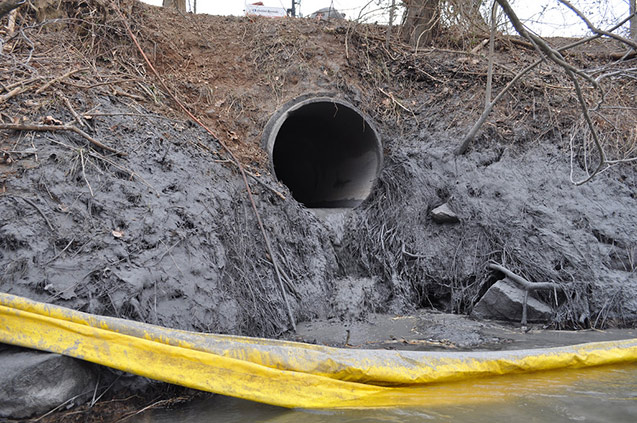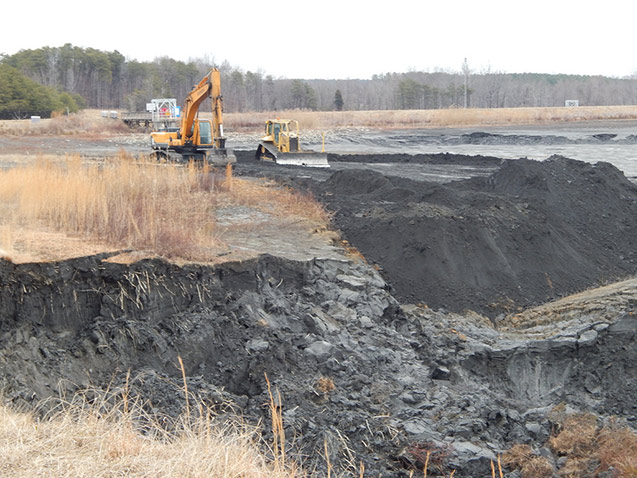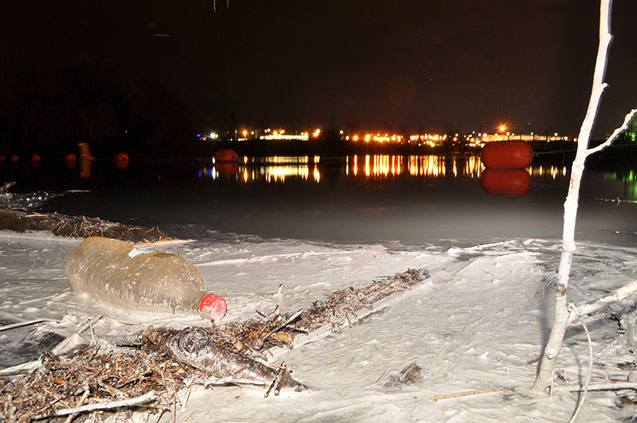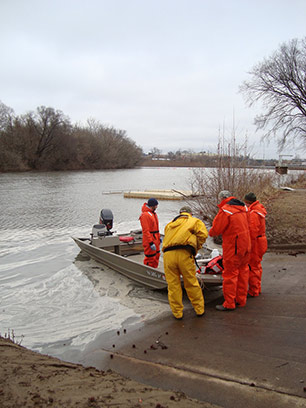Part of the Series
Planet or Profit
 (Photo: Appalachian Voices / Flickr)
(Photo: Appalachian Voices / Flickr)Duke Energy’s coal ash pond in Eden, North Carolina, was a ticking time bomb. For more than 50 years, Duke Energy dumped ash and other wastes from a power plant in two unlined ponds next to the Dan River. The plant shut down in 2012, but the company just left the ash waste sitting in the ponds, the larger of the two measuring 27 acres across. On February 2, a busted stormwater pipe under the primary pond released millions of gallons of toxic sludge into the Dan River, which provides drinking water for communities downstream.
It took Duke Energy, the nation’s largest electricity producer, more than 24 hours to publicly report the spill and an additional six days to permanently plug the leak as an estimated 82,000 tons of ash turned the Dan River grey and contaminated its waters with dangerous levels of arsenic and other heavy metals. Duke Energy is currently working to contain and remove a 300-cubic-yard deposit of ash from the river.
The spill sounds like an unprecedented environmental disaster, but it’s not. In December 2008, coal ash impoundment maintained by the Tennessee Valley Authority in Kingston, Tennessee, burst open and 1.1 billion gallons of toxic sludge flooded out, destroying homes, streams and wetlands. Another TVA pond in Alabama leaked 10,000 gallons of coal waste sludge into a stream a month later. In August 2005, a coal ash pond at PPL’s Martins Creek Power Station in Bangor, Pennsylvania, failed, spilling 100 million gallons of ash across 10 acres of land and into the Delaware River. And the list of accidents and spills goes on.
 (Photo: Duke Energy / Flickr)
(Photo: Duke Energy / Flickr)
Coal ash is the nation’s largest waste stream. More than 140 million tons of the waste – a mixture of ash, boiler slag and desulfurization sludge removed from smokestacks – is produced by America’s power plants every year, and the industry estimates that 3 billion tons of coal ash has been generated since the beginning of the last century. Some of the waste is recycled, but much of it simply has been stored in more than 1,000 ponds, impoundments and landfills across the country.
Like the Duke Energy pond that leaked in North Carolina, at least 535 of the nation’s ash ponds operate without a liner that would prevent chemicals and heavy metals from leaching into water sources. Coal ash can contain mercury, selenium, arsenic, chromium and other toxic and heavy metals, and at least 207 spills and contamination events have occurred in 37 states, according to data compiled by environmental groups. A 2010 Environmental Protection Agency (EPA) review found that people living near unlined coal ash dumps have a one in 50 chance of developing cancer from arsenic contamination. The agency said last week that arsenic contamination is one of the main concerns that drew federal officials to the Dan River spill in North Carolina.
Weak State Regulation
The EPA, however, continues to exempt coal ash from federal regulation and classifies coal ash as a nonhazardous waste in the same class as household garbage, leaving the oversight of coal ash storage up to state agencies that have notoriously weak enforcement standards for the nation’s aging fleet of coal ash dumps. A 2013 review of regulations in 37 states by the environmental group Earthjustice found that only three states require composite liners for all new coal ash ponds and only two states require groundwater monitoring. Despite the growing list of coal ash disasters, only 17 states require regulatory inspections of the structural integrity of coal ash dams and ponds.
 (Photo: Appalachian Voices / Flickr)
(Photo: Appalachian Voices / Flickr)
State regulators also are known for working closely with the industries they are supposed to regulate. Environmentalists say that is the case in North Carolina, where Republican Gov. Pat McCrory is a former Duke Energy employee and environmentalists have been highly critical of the state’s response to the Dan River spill. Since his unsuccessful run for governor in 2008, Duke Energy and affiliated political groups and donors have spent $1.1 million supporting McCrory’s candidacy, according to reports.
“Waterkeeper doesn’t have a lot of confidence that the McCrory administration is going to adequately investigate this spill and require Duke to do a full cleanup,” said Donna Lisenby, a campaigner with the Waterkeeper Alliance, one of the first environmental groups to respond to the spill.
Environmentalists were enraged when initial reports from the North Carolina Department of Environment and Natural Resources (DENR) seemed to downplay the extent of the disaster at Dan River. State regulators initially reported last week that water samples did not show levels of pollutants, including several heavy metals, exceeding state water standards. Samples taken by the Waterkeeper Alliance shortly after the spill, however, showed dangerously high levels of arsenic, chromium, lead and other contaminants typically found in coal ash.
 (Photo: Appalachian Voices / Flickr)DENR later issued a correction claiming it made an “honest mistake” in interpreting its results for arsenic, which had contaminated the river at levels that endanger the health of humans and wildlife. The agency warned the public to stay out of the river.
(Photo: Appalachian Voices / Flickr)DENR later issued a correction claiming it made an “honest mistake” in interpreting its results for arsenic, which had contaminated the river at levels that endanger the health of humans and wildlife. The agency warned the public to stay out of the river.
A press release from the McCrory administration last week boasted about the legal action the state has taken to force Duke Energy to clean up its leaking coal ash ponds across the North Carolina. But the state stepped in last year only after environmental groups threatened to take Duke Energy to court over alleged coal ash contamination at several sites. DENR then took over the lawsuits from the environmental groups and, in two cases, negotiated a deal with Duke Energy that did not require any comprehensive cleanup and simply levied a $99,111 fine against the $50 billion company. The state asked a judge to disregard that original settlement this week in light of the Dan River spill and after news reports brought critical attention to the original deal.
DENR spokesman Jamie Kritzer told Truthout on Monday that state regulators must continue their investigation of the Dan River spill before enforcing environmental laws against Duke Energy.
“It’s probably premature to be talking about fines,” Kritzer said. ” … We’ve worked with the utility to get this thing stopped, the next step will be to continue to assess what kind of things are in the river and assess the damages that occurred to the environment.”
Kritzer said enforcement actions against Duke Energy could come from both the EPA and DENR, but it’s unclear what that enforcement would look like, although there has “obviously” been a violation of Duke Energy’s pollution discharge permits. Kritzer said DENR is “in it for the long haul” because cleanup and monitoring of the Dan River could take years. Kritzer would not comment on whether the Dan River spill might inspire some changes in the way North Carolina regulates coal ash, but he did say the spill would “raise people’s eyebrows and open their eyes to the potential for changes.”
New Federal Rules for Coal Ash
In the meantime, environmentalists will turn their attention to the EPA, which could propose stricter federal rules for coal ash waste this year.
Soon after the Obama administration took office in 2009, the EPA pledged to make new rules for coal ash in the wake of the Kingston spill. The agency finally made some proposals in 2010 but has dragged its feet in the face of industry criticism ever since. Environmental groups recently challenged the EPA in court to force a rulemaking, and in October 2013, a federal judge ruled that the agency must act. Just days before the massive spill in the Dan River, the EPA announced a December 2014 deadline to finalize the first-ever federal rules for coal ash.
The EPA has the option to issue rules that would continue classifying coal ash as a nonhazardous waste and leave much of its regulation up to state agencies. The agency also could decide to designate coal ash as a “special waste” that would require more federal oversight. Environmentalists are crossing their fingers in hopes that the EPA will learn a lesson from the Dan River spill and take the high road toward stricter regulations that could force utility companies to close many of their open-air ash dumps for good.
We have 10 days to raise $50,000 — we’re counting on your support!
For those who care about justice, liberation and even the very survival of our species, we must remember our power to take action.
We won’t pretend it’s the only thing you can or should do, but one small step is to pitch in to support Truthout — as one of the last remaining truly independent, nonprofit, reader-funded news platforms, your gift will help keep the facts flowing freely.